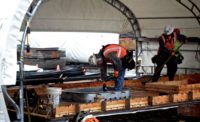A project in Kansas City is drawing comparisons to New York City’s High Line and the Chicago Riverwalk.
Developer Flying Truss, LLC, is planning to redevelop the Rock Island Bridge, a disused early 20th century steel truss railroad bridge, into what it calls a “destination landmark bridge.”
Flying Truss is planning to more-than-double the width of the bridge to accommodate new restaurants, bars and event spaces spread across two decks. The project will also include the addition of a new public path that will connect to a regional rail-to-trail network.
“There’s a lot of bump-outs on bridges where you stop your 10-speed and take a squirt of water and look around, but nobody’s taken it to this level,” Flying Truss partner Michael Zeller said during a presentation in May.
The 700-ft bridge consists of three 55-ft-tall trusses. The first two built in 1905 are 302-ft-long each, and a 90-ft-long eastern truss was added in 1912 when the channel was widened.
The Rock Island Bridge connects Kansas City, Kan., Armourdale neighborhood in the west to Kansas City, Mo., West Bottoms on the eastern bank. The area was once home to the world’s second-largest beef processing center, and the bridge carried railroads serving that industry over the Kansas River, or Kaw, as it’s known by locals. The bridge has sat mostly unused for decades.
“It’s blighted,” Katherine Carttar, the director of economic development for the Unified Government of Wyandotte County and Kansas City, Kan., said during a meeting on the project earlier this year. “It’s really a safety concern, honestly, at this point.”
Zeller said the initial plan was to lease the bridge and use it as an event space. But when officials asked about including a public foot crossing on the bridge, the scope of the project grew into what Zeller has likened to an Italian piazza, but 40 ft over a river.
Fortunately, a 2016 engineering report from TranSystems found the bridge’s structure is still sturdy enough to use, despite its age and neglect. It found the bridge can hold 3.16 million lbs, and Flying Truss anticipates a static load of just a third of that.
“They found it to be quite robust and able to carry enormous weights,” Zeller said during a Unified Government Commission meeting in May.
In order to have room for the public path and the restaurants and other businesses, Flying Truss plans to add steel cantilevers jutting out 13 ft from each side of the center truss to hold an 85-yd-long, 11,000-sq-ft concrete pad. It will also build a 75-yd-long, 8,000-sq-ft upper deck, which will be accessed via two staircases and an ADA-compliant elevator.
Gould Evans Architects is leading the project design. Thornton Tomasetti is engineering the new structures and TranSystems conducted an initial inspection report on the bridge, and worked with the architect on the preliminary designs. No contractor has been named yet.
Capital costs for the project are expected to total $4.5 million, and construction is expected to start next Spring.
The lower deck will serve as a main “entertainment district,” according to Flying Truss. There will be two industrial kitchens for restaurants, plus a space for a cafe and bar, restrooms and other amenities. Two popular Kansas City restaurants, Slap’s BBQ and Buffalo State Pizza, have already signed letters of intent for the space, and a local bar owner will handle alcohol sales, according to Zeller. The upper deck will include a 250-person event space available for rent.
On the western end of the bridge, Flying Truss has also planned a “community zone” that will include spaces for local nonprofits that promote riding the bike trails or kayaking and canoeing the river.
The Kansas Department of Tourism has estimated the bridge will attract 360,000 visitors in its first year, though Flying Truss is using a more conservative estimate of 250,000.
The Rock Island Bridge is slated to open in 2023.
Local governments have OK’d the plans. The Unified Government’s economic development department has committed to investing $2 million in the project. Locals are hoping the bridge project could serve as a catalyst for more redevelopment in the area.
There are already efforts underway to redevelop the neighborhoods on both sides of the bridge. In Missouri, a major mixed-use project with hundreds of apartments and more than 5,500 sq-ft of retail space is being built in West Bottoms, and the new owners of the nearby Hy-Vee Arena recently renovated the building into a multi-function sports complex. On the Kansas side, Armourdale is in the midst of creating a new master plan that residents are hoping will breathe fresh life into the river-ringed neighborhood. The Army Corps of Engineers is planning to raise the levee along the river, which will create 20 miles of new trail.
“A lot of the cool things in cities around the country were once sort of forgotten areas — an old shoe factory that was abandoned, a creek through the middle of a city that was very much unloved,” Zeller said during his presentation. “… And when you turn them into something fun, they become an important placemaking vehicle.”





